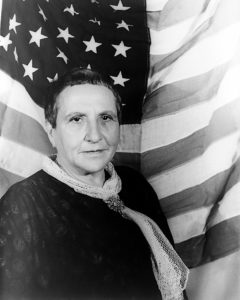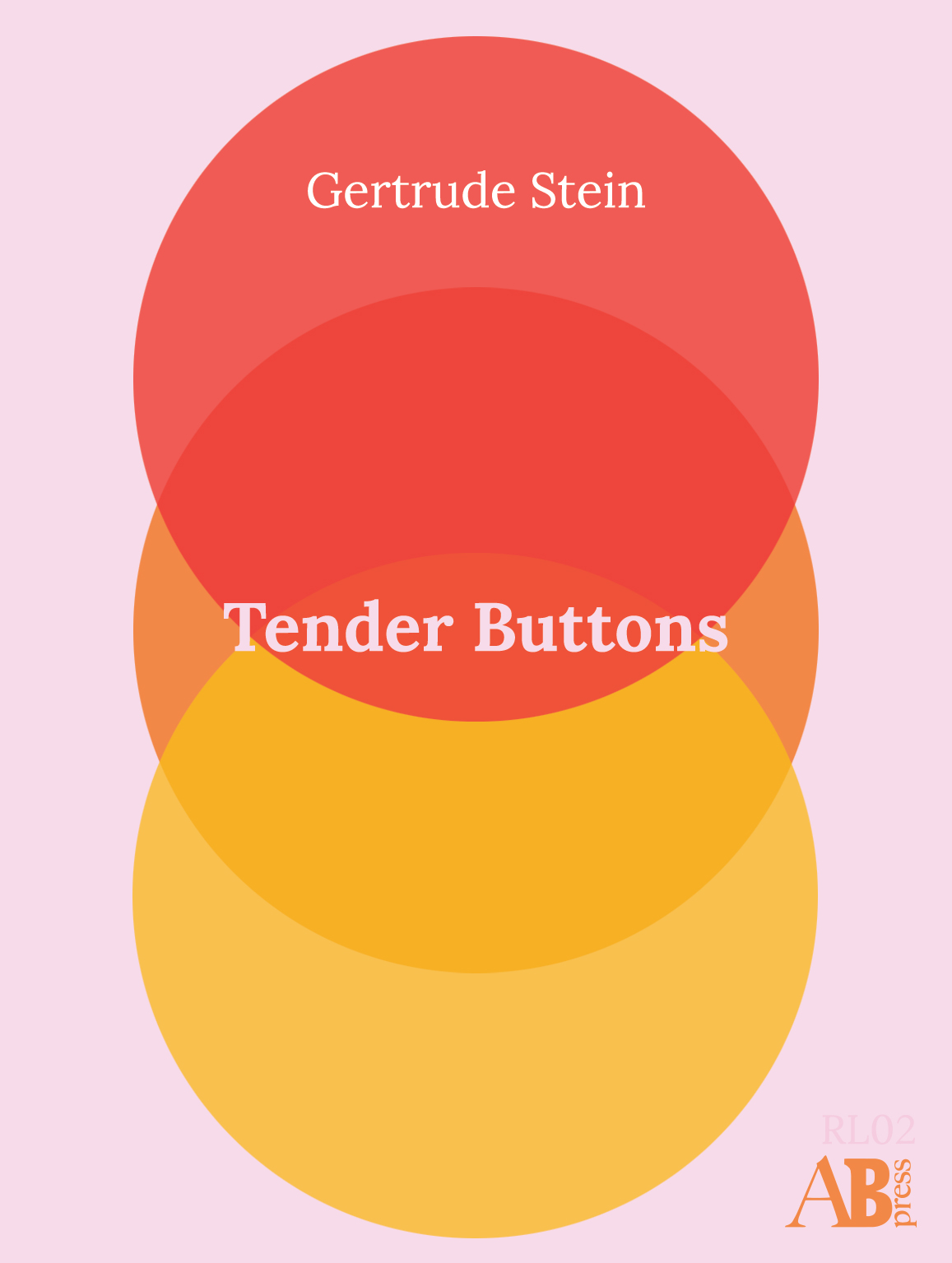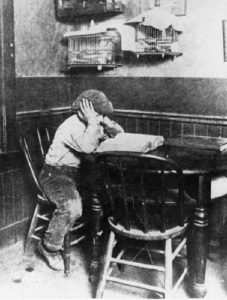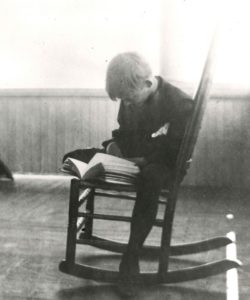Biography
 GERTRUDE STEIN (1874-1946) was born in Allegheny, Pennsylvania, into a wealthy family of German-Jewish immigrants. Her father was a railroad executive and a shrewd businessman; his business commitments meant the family moved to Vienna, briefly Paris, and then returned to settle in Oakland, California.
GERTRUDE STEIN (1874-1946) was born in Allegheny, Pennsylvania, into a wealthy family of German-Jewish immigrants. Her father was a railroad executive and a shrewd businessman; his business commitments meant the family moved to Vienna, briefly Paris, and then returned to settle in Oakland, California.
Gertrude completed her first book when aged only eight. She was a kaleidoscopic reader on all subjects, and was fascinated by grammar and sentence construction at an early age. She obtained a degree in psychology from Radcliffe College, and eventually went on to medical school, although no career in medicine resulted.
From 1902 Stein lived with her brother Leo in Paris, with whom she shared similar interests; he was an art critic. (It would be thirty years before she saw America again.) In Paris she met Alice B. Toklas, who was to become her lifelong partner, and who moved in with Gertrude and Leo in 1910. Gertrude compiled one of the first collections of Cubist and modern art, and with Ann astute eye she acquired early works by Matisse, Derain, Braque, Gris, and Picasso (who later became a firm friend; Picasso painted Stein’s portrait). By the 1920s, her Parisian salon was much visited; Matisse, Hemingway, Ezra Pound, Wilder and other ex-patriate American writers were regular visitors; Stein was to become godmother to Hemingway’s eldest son.
The First World War broke out when Stein and Toklas were visiting England. A return to France to ensued and both served as volunteer drivers, for which work they were honoured by the French Government.
Gertrude Stein had written her first novel, Q.E.D., in 1903, but it wasn’t published until 1950 under the title Things As They Are. It is probably the first ‘coming out’ book, and was based on the love triangle she had engaged with at John Hopkins, Baltimore. Her best known and most profitable book, The Autobiography of Alice B. Toklas, was written in the 1930s. Miss Furr and Miss Skeene, 1922, contains the word ‘gay’ over one hundred times, and is possibly the first published use of the word.
Gertrude Stein’s experimental style included disconnectedness, a love of refrain and rhyme, rhythm and balance, a dislike of punctuation, a dismissal of the conventional significance of words, and repetition, repetition, repetition. How To Write was published in 1931 and is an accessible introduction to her avant-garde and experimental techniques. Stein was fascinated by grammar and sentence construction from an early age ; she started to write when only eight years old, was a kaleidoscopic reader. For most of her literary life she sought to alter the perspective of literature and its significance, and she used an unconventional style that promulgated new directions in experimental writing. She is described often as the literary equivalent of Cubism, an art movement that Stein was deeply interested in: she collected Cubist works voraciously, and Picasso was a great friend.
Gertrude and Alice were both Jewish, though they remained in France during the Second World War and lived under the protection of Pétain in various country houses. They became friends of Bernard Fay, a collaborator with the Vichy regime. Stein’s status rose after 1945, and her house became the place to be for a myriad of young American soldiers. She died of stomach cancer in 1946 and is interred in the Père Lachaise cemetery.
by Sherwood Anderson
THE WORK OF GERTRUDE STEIN
by Sherwood Anderson
ONE evening in the winter, some years ago, my brother came to my rooms in the city of Chicago bringing with him a book by Gertrude Stein. The book was called Tender Buttons and, just at that time, there was a good deal of fuss and fun being made over it in American newspapers. I had already read a book of Miss Stein’s called Three Lives and had thought it contained some of the best writing ever done by an American. I was curious about this new book.
My brother had been at some sort of a gathering of literary people on the evening before and someone had read aloud from Miss Stein’s new book. The party had been a success. After a few lines the reader stopped and was greeted by loud shouts of laughter. It was generally agreed that the author had done a thing we Americans call “putting something across”—the meaning being that she had, by a strange freakish performance, managed to attract attention to herself, get herself discussed in the newspapers, become for a time a figure in our hurried, harried lives.
My brother, as it turned out, had not been satisfied with the explanation of Miss Stein’s work then current in America, and so he bought Tender Buttons and brought it to me, and we sat for a time reading the strange sentences. “It gives words an oddly new intimate flavor and at the same time makes familiar words seem almost like strangers, doesn’t it,” he said. What my brother did, you see, was to set my mind going on the book, and then, leaving it on the table, he went away.
And now, after these years, and having sat with Miss Stein by her own fire in the rue de Fleurus in Paris I am asked to write something by way of an introduction to a new book she is about to issue.
As there is in America an impression of Miss Stein’s personality, not at all true and rather foolishly romantic, I would like first of all to brush that aside. I had myself heard stories of a long dark room with a languid woman lying on a couch, smoking cigarettes, sipping absinthes perhaps and looking out upon the world with tired, disdainful eyes. Now and then she rolled her head slowly to one side and uttered a few words, taken down by a secretary who approached the couch with trembling eagerness to catch the falling pearls.
You will perhaps understand something of my own surprise and delight when, after having been fed up on such tales and rather Tom Sawyerishly hoping they might be true, I was taken to her to find instead of this languid impossibility a woman of striking vigor, a subtle and powerful mind, a discrimination in the arts such as I have found in no other American born man or woman, and a charmingly brilliant conversationalist.
“Surprise and delight” did I say? Well, you see, my feeling is something like this. Since Miss Stein’s work was first brought to my attention I have been thinking of it as the most important pioneer work done in the field of letters in my time. The loud guffaws of the general that must inevitably follow the bringing forward of more of her work do not irritate me but I would like it if writers, and particularly young writers, would come to understand a little what she is trying to do and what she is in my opinion doing.
My thought in the matter is something like this—that every artist working with words as his medium, must at times be profoundly irritated by what seems the limitations of his medium. What things does he not wish to create with words! There is the mind of the reader before him and he would like to create in that reader’s mind a whole new world of sensations, or rather one might better say he would like to call back into life all of the dead and sleeping senses.
There is a thing one might call “the extension of the province of his art” one wants to achieve. One works with words and one would like words that have a taste on the lips, that have a perfume to the nostrils, rattling words one can throw into a box and shake, making a sharp, jingling sound, words that, when seen on the printed page, have a distinct arresting effect upon the eye, words that when they jump out from under the pen one may feel with the fingers as one might caress the cheeks of his beloved.
And what I think is that these books of Gertrude Stein’s do in a very real sense recreate life in words.
We writers are, you see, all in such a hurry. There are such grand things we must do. For one thing the Great American Novel must be written and there is the American or English Stage that must be uplifted by our very important contributions, to say nothing of the epic poems, sonnets to my lady’s eyes, and what not. We are all busy getting these grand and important thoughts and emotions into the pages of printed books.
And in the meantime the little words, that are the soldiers with which we great generals must make our conquests, are neglected.
There is a city of English and American words and it has been a neglected city. Strong broad shouldered words, that should be marching across open fields under the blue sky, are clerking in little dusty dry goods stores, young virgin words are being allowed to consort with whores, learned words have been put to the ditch digger’s trade. Only yesterday I saw a word that once called a whole nation to arms serving in the mean capacity of advertising laundry soap.
For me the work of Gertrude Stein consists in a rebuilding, an entire new recasting of life, in the city of words. Here is one artist who has been able to accept ridicule, who has even forgone the privilege of writing the great American novel, uplifting our English speaking stage, and wearing the bays of the great poets, to go live among the little housekeeping words, the swaggering bullying street-corner words, the honest working, money saving words, and all the other forgotten and neglected citizens of the sacred and half forgotten city.
Would it not be a lovely and charmingly ironic gesture of the gods if, in the end, the work of this artist were to prove the most lasting and important of all the word slingers of our generation!
Selected bibliography
The Gertrude Stein Reader
A showcase which collects thirty-five of her provocative poems, short fiction, plays, writing for opera and film, essays and verbal portraits.
The Making of Americans
Stein sets out to tell “a history of a family’s progress,” radically reworking the traditional family saga novel to encompass her vision of personality and psychological relationships. As the book progresses over three generations, Stein also meditates on her own writing, on the novel, and on America.
A Novel of Thank You
A midcareer assessment of herself, her writing and her relationships. In place of a traditional story, Stein explores the nature of narrative, its possibilities, the various genres available to the writer, the conventions of novel writing, and the novelist’s relation to her materials; the novel is about “preparing a novel” (see chapter 50), and about everything that goes through a writer’s head as she begins to write.
Paris France
A witty and anecdotal account of a love affair with France, through childhood memories and a cultural commentary.
How to Write
Her experimental style included disconnectedness, a love of refrain and rhyme, rhythm and balance, a dislike of punctuation, a dismissal of the conventional significance of words, and repetition. Published in 1931, this explains all and is an accessible and splendid introduction to her work.
 GERTRUDE STEIN (1874-1946) was born in Allegheny, Pennsylvania, into a wealthy family of German-Jewish immigrants. Her father was a railroad executive and a shrewd businessman; his business commitments meant the family moved to Vienna, briefly Paris, and then returned to settle in Oakland, California.
GERTRUDE STEIN (1874-1946) was born in Allegheny, Pennsylvania, into a wealthy family of German-Jewish immigrants. Her father was a railroad executive and a shrewd businessman; his business commitments meant the family moved to Vienna, briefly Paris, and then returned to settle in Oakland, California.




 Allen Lane, the founder of Penguin books, was a man who liked to be seen riding a virtuous horse though his spurs were as sharp as an abacus: money was his game and he chanced to sell his new Penguin range through his Penguincubator in 1937, in tobacconists alongside newspapers and boiled sweets, also a few placed as concessions in branches of F. W. Woolworth’s. One Penguincubator was commissioned at Charing Cross Station, placed next to a machine vending cigarettes. (6d the price of a packet of fags, 6d the price of the first Penguins, though am not sure if Lane had thought through how you were supposed to keep the books alight without a filter.) Booksellers in the Charing Cross locality objected to the Penguincubator and it was removed. It would seem that they were never successful in any case.
Allen Lane, the founder of Penguin books, was a man who liked to be seen riding a virtuous horse though his spurs were as sharp as an abacus: money was his game and he chanced to sell his new Penguin range through his Penguincubator in 1937, in tobacconists alongside newspapers and boiled sweets, also a few placed as concessions in branches of F. W. Woolworth’s. One Penguincubator was commissioned at Charing Cross Station, placed next to a machine vending cigarettes. (6d the price of a packet of fags, 6d the price of the first Penguins, though am not sure if Lane had thought through how you were supposed to keep the books alight without a filter.) Booksellers in the Charing Cross locality objected to the Penguincubator and it was removed. It would seem that they were never successful in any case.